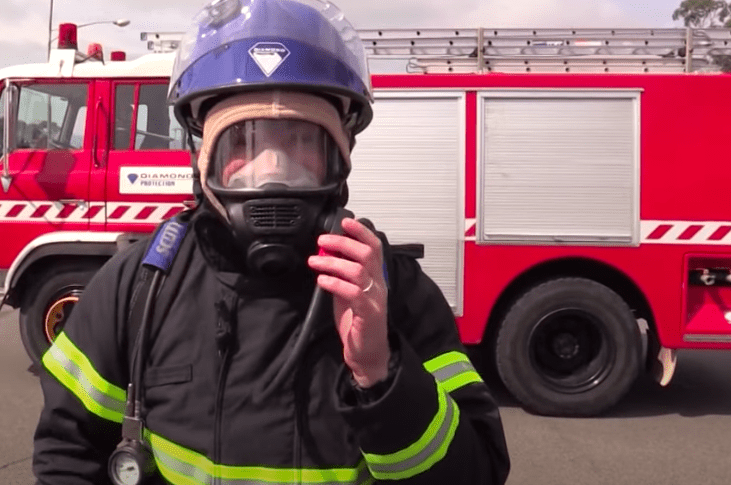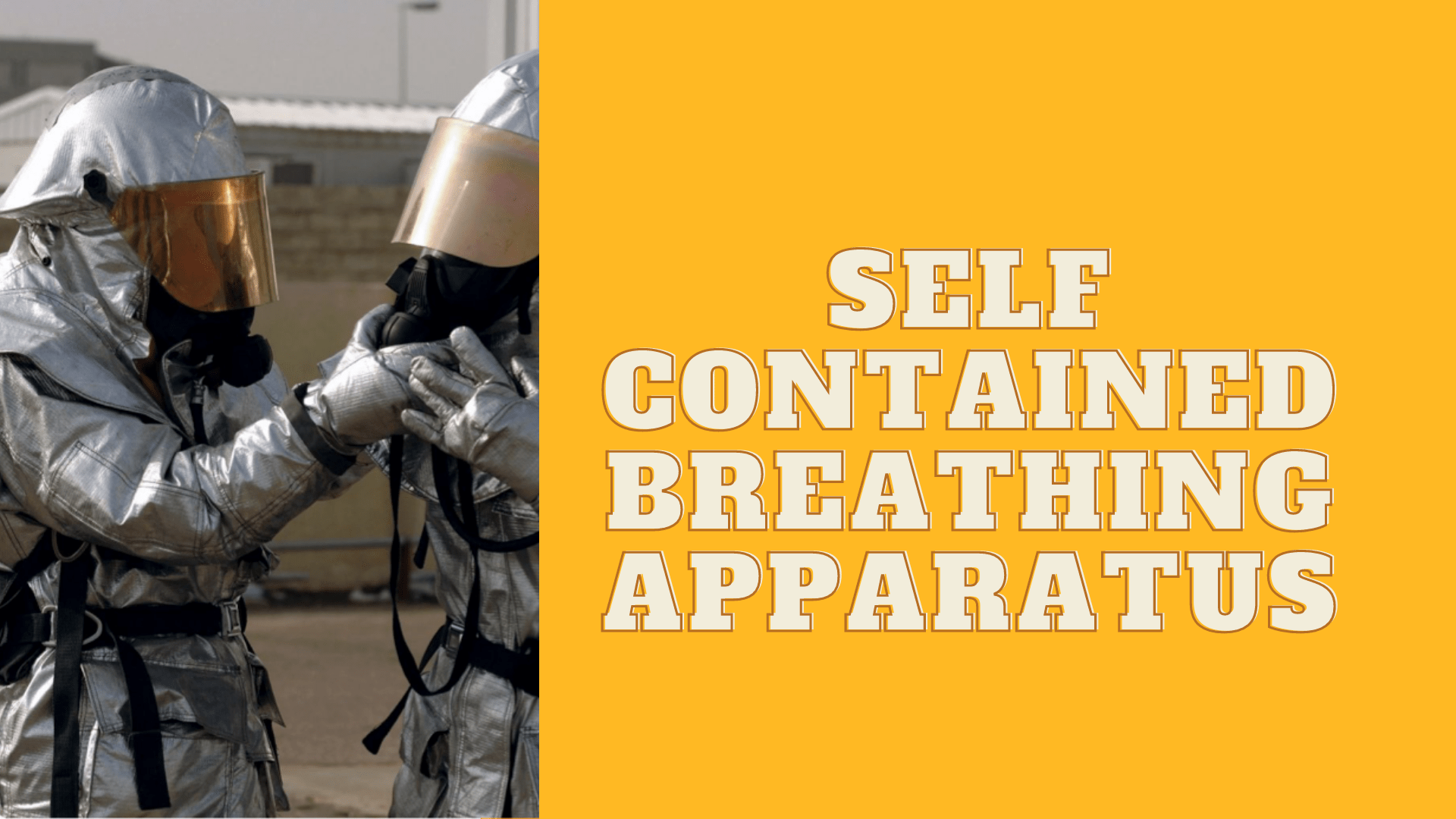
Image source – Diamond Protection
Fire products of combustion displace the oxygen content, and poisonous or irritant vapours are evolved. Such condition makes the wearing of some form of breathing apparatus. We will look into this article about what are the different types of Breathing apparatus used and why SCBA (self contained breathing apparatus ) is popular .
Main categories
Atmospheric (depends on atmosphere for air supply)
Self-contained Breathing Apparatus (i.e., carries independent air supply)
Atmospheric type
i) Antipoys.
ii) Smoke helmets or masks.
iii) Masks or respirators for industrial gases.
Antipoys
This type contains:
- Respirator type face piece.
- Inhaling and Exhaling valves.
- Equaliser tube acts as a reservoir.
- Distance 90 ft.
- Strainer on air supply tubing must be fresh air.
- Air supply depends on wearer lung movements.
ii) Smoke helmets or masks.
In this type a mask is supplied with air through a flexible hose from either a bellows unit or a rotary blower. It contains:
- 60 ft length of reinforced tubing ( max of 120 ft ).
- Bellows or compressor to supply fresh air.
- 130 ft wire fireproof lifeline.
Face mask type must be adjusted to fit the face correctly before the wearer ventures into a smoke-laden atmosphere. This can be checked by nipping the supply line or stopping the supply of air at the valve and trying to breath in, when the mask should be drawn tight in to the face and any leakage from outside is made obvious.
Advantages of Antipoys and Smoke helmets or masks: –
- No time limit
- Cooler air in use
- Little knowledge require to train personnel
- Care and maintenance easy
- Testing simple
- Mask is at positive pressure provided pumping rate are maintained.
Disadvantages of Antipoys and Smoke helmets or masks: –
- All intakes must be carefully watched (smoke / fumes)
- Two or more men required
- Tubing heavy, difficulty in laying hose lines
- Air supply line may be damaged or trapped
- Reduced pressure by partial vacuum in antipoys
- Limited to distance.
iii) Industrial Masks or respirators for industrial gases
All these types are dependent on there being sufficient oxygen present. Should only be used in specific toxic atmospheres. Useless in smoky atmospheres.
Self contained Breathing Apparatus types
Compressed air all cylinders: – colour , Grey – black and white shoulders.
SIEBE GORMAN ‘AIRMASTER’
- Compressed air industrial type set.
- Open circuit exhaling to atmosphere.
- Single cylinder.
- Contains 1240 litres
- Charged to 132 atmospheres ( full ).
Valves hand operated: – 1. Main valve, 2. By-pass valve,
Valves automatic:
- Reducing valve – controls flow of high-pressure air to 80 p.s.i.
- Demand valve – allows airflow to face mask on inhalation phase only.
- Inhalation valve.
- Exhalation valve.
Method of operation:
A face piece, fitted with demand valve. Partial vacuum on inhaling causes movement of diaphragm to depress lever, air at 80 psi (6 kg/cm2) lifts valve, which allows air to pass to wearer. A small spring ensures return of lever and closing of valve after each inhalation.
Time factor: According to manufacturers: –
- Moderate work – 60 minutes.
- Hard work – 26 minutes.
Testing of Self Contained Breathing Apparatus
- Ensure by-pass valve closed.
- Open main valve fully – warning whistle will sound as gauge needle past Red low-level indicator.
- Take gauge reading.
- Hold face piece to face, inhale and exhale deeply to ensure lung demand valve, exhaling and inhaling valves are functioning correctly.
- Turn off main valve. Gauge reading should remain constant.
- Release pressure.
How to use Self Contained Breathing Apparatus:
- Adjust the shoulder straps so that set is comfortable to wear.
- Place the looped strap of the face piece over the head.
- Open the main valve fully.
- Put the face piece on chin first then tightens from bottom straps and test for air tightness by turning off main valve momentarily inhaling, the face piece should now collapse to face.
- If all is correct, work may be carried out until the pressure reading or whistle sounding it is time to return to fresh air.
- Read the gauge at regular intervals. Careful note must be taken of the time used to reach the objective and ample time allowed to return to a respirable atmosphere.
- The by-pass is for emergency use only, it should normally be kept closed, but should difficulty in breathing be experienced then open the by-pass gently so that it gives sufficient air for comfortable breathing.
Remember that when the by-pass is open a continuous flow of air is provided resulting in wastage of air, therefore the valve should be opened no wider than is necessary.
SIEBE-GORMAN ( Marine ) INTERNATIONAL SET (C.A.B.A.) Mk2
The international is a versatile twin cylinder, two stage breathing apparatus with each cylinder charged to a pressure of 2840 p.s.i (200 kg/cm2).
Both cylinders attached with hand wheel connections to a centrally placed reducing valve, which is set at a pressure of 80 p.s.i. And which incorporates a by-pass valve; auxiliary airline adopter and pressure gauge take off point and low-level cylinder warning device (whistle).
The second stage demand valve is located on the front of a Vistarama full-face mask and is linked to the reducing valve by a low-pressure air hose.
An aluminium back plate holds both cylinders with one centrally secured retaining strap, and supported on to the back of the wearer by a terylene harness. A short hemp covered wire lanyard is attached to the back plate in a D ring to facilitate the attachment of a safety or lifting line.
* Familiarity with the apparatus is essential and to facilitate this it would be useful to have on board a compressor, which delivers oil free air to re-charge the bottle.
